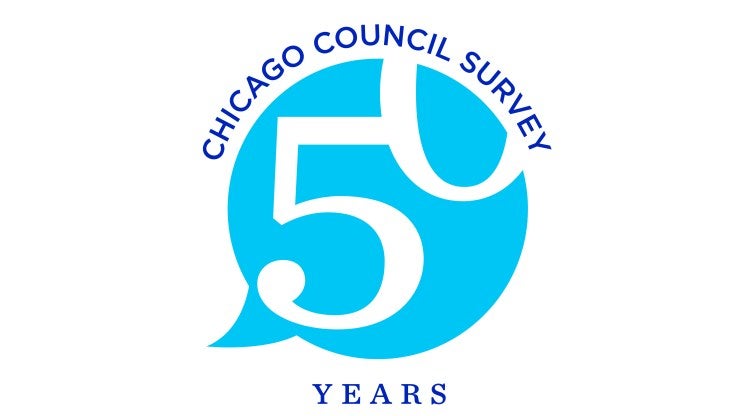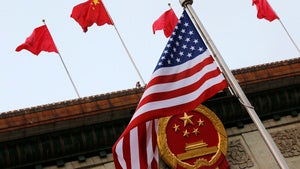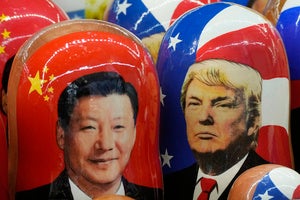While Republicans remain focused on limiting China's rise, a majority of Americans now favor a policy of cooperation and engagement with Beijing.
US President Donald Trump and Chinese President Xi Jinping will meet later this week at the Asia-Pacific Economic Cooperation (APEC) forum in South Korea. Trade issues will be high on the agenda, including China’s restrictions on rare earth elements, a potential TikTok deal, and Chinese access to US semiconductor technologies. The first meeting of the two leaders since Trump’s return to the White House will also help set the tone of the broader US-China relationship, which has been characterized in recent years by public spats, tensions around Taiwan, espionage revelations, and an extensive trade war.
The 2025 Chicago Council Survey, fielded July 18–30, finds that the bipartisan embrace of US-China competition no longer holds among the public, with partisan differences in perceived threats from China and disagreements on current US-China trade policy. While Republicans continue to favor limiting China’s rise, as well as reductions in trade, and view US-China trade as detrimental to US national security, Democrats have moved in the other direction. Driven by shifts among Democrats and Independents, a majority of Americans now favor a policy of cooperation and engagement with Beijing, oppose higher tariffs, and oppose cuts to bilateral trade.
Key Findings
- A majority of Americans (53%) now say the United States should undertake friendly cooperation and engagement with China, up from 40 percent in 2024.
- Two-thirds of Democrats (66%) prefer the United States to undertake friendly cooperation and engagement with China rather than actively work to limit China’s influence, an increase of 19 percentage points from 2024. Just a third of Republicans (33%) agree.
- Americans are now divided over whether US-China trade weakens (48%) or strengthens (47%) US national security, a shift from 2024, when most Americans believed it weakened US security.
- A majority of Democrats (60%) now believe US-China trade strengthens US national security while Republicans (63%) continue to see it as weakening US national security.
- Americans overall (54%), as well as majorities of Democrats (81%) and Independents (58%), oppose higher tariffs on Chinese imports; a majority of Republicans (67%) support higher tariffs.
- Across party lines, Americans favor reducing tariffs on Chinese imports in exchange for China reducing its trade deficit with the United States (66%; 73% Democrats, 65% Independents, 63% Republicans).
American Views of China Rebound to Pre-Pandemic Levels
Americans’ views of China are beginning to improve after several years of sharp declines. A year after hitting record lows in the Council’s nearly 50-year-long trend, American views of China have rebounded. Today, on a zero to 100 scale where zero represents a very negative feeling and 100 a very positive feeling, Americans give China an average of 35. This is up from an average of 24 in August 2024 and is the highest result recorded in Council polling since the COVID-19 pandemic began in 2020. This overall shift is driven primarily by improving views among Democrats and Independents. Democrats today give China an average rating of 42, up from 29 in 2024, while Independents rate China a 38, up from 22 a year ago.
Shifting threat perceptions are also part of the explanation. As Council polling shows, Democrats today are far more focused on America’s internal problems—including government corruption and threats to US democracy—than they are about the rise of China. And trade issues are a final critical factor.
Americans See US and China as Top Two Global Powers
The US-China relationship is widely viewed as the most consequential bilateral relationship in the world—and for good reason. The two nations, combined, are home to over 40 percent of global GDP and over half of global military spending. Americans have long viewed the United States and China as the two most globally influential nations, with the United States in the leading spot. And although the public is confident in American military superiority over China, Americans are less confident that the United States is still the stronger economic power.
When asked to rate the global influence of the United States and China on a zero to 10 scale, Americans see the two nations as the two most globally influential countries in the world, with the United States (8.6) remaining ahead of China (7.5). Public perceptions of the comparative influence of Washington and Beijing since 2018 have remained fairly stable, with neither country really narrowing nor expanding the gap—at least in Americans’ minds. Nor have partisan attitudes on international influence shifted significantly. However, Republicans do see the United States as notably more influential than China (9.0 vs. 7.3), while Democrats see the two nations as closer in influence (8.4 vs. 7.7) (see appendix).
Americans Confident in US Military Power, Divided on US-China Economic Strength
However, when Americans think more specifically about specific aspects of power, their views become more nuanced. The public is, and has been, confident about the American advantage in military power. Half of Americans (53%) say the United States is stronger militarily than China, while a third (34%) view the two nations as about equal. Just 11 percent say China is the stronger military power.
American perceptions of the US-China balance of economic power are less set, with public views swinging back and forth over the past decade. Today Americans are evenly split, with a third (34%) seeing the United States as the stronger economic power, another third (33%) seeing China as stronger, and three in 10 (31%) seeing the two nations as about equally matched in economic power.
As with most questions about US-China relations, there are notable partisan differences when it comes to perceptions of the balance of power. Republicans are more confident that the United States is stronger than China both militarily (63%) and economically (50%). Democrats see the United States as the stronger military power (51%) but have lost confidence in US economic power (27%, down from 39% in 2023). Independents feel similarly: They are generally confident in US military superiority (49%) but are less confident in the US economically, where only 28 percent say the United States is the stronger economic power.
Majority Now Prefer Friendly Cooperation and Engagement with China
Since the first Trump administration’s 2017 National Security Strategy, US-China relations have been defined by the framework of “=Great Power Competition.” The administration of President Joe Biden continued this approach, framing its strategy as “invest, align, compete”—investing domestically, aligning with allies and partners, and competing with China—while also cooperating with China where interests might align. The second Trump administration has leaned heavily into the competition side of that approach, imposing high tariffs on Chinese goods and escalating the Biden administration’s attempts to cut China off from high-tech semiconductor imports. Yet the American public is moving in a different direction. The public is moving in favor of cooperation and engagement with Beijing, is less concerned about China’s rise as a threat, and is less likely now to prioritize limiting China’s influence around the world.
In a sharp reversal from 2024, a majority of Americans (53%) now say the United States should undertake friendly cooperation and engagement with China, while 44 percent prefer a policy of actively limiting the growth of China’s power. This is the first time since 2019 that a majority of Americans have preferred a policy of cooperation and engagement with China.
This shift is primarily driven by Democrats’ change in opinion. Today, two-thirds of Democrats (66%) prefer that the United States undertake friendly cooperation and engagement with China, an increase of 19 percentage points from 2024. Just a third of Republicans (33%) agree—and at 33 percentage points, this is the largest partisan gap between Republicans and Democrats on this question since it was first asked in 2006. Independents have also shifted notably in attitudes, with a majority (56%, up from 44% in 2024) now favoring a policy of cooperation and engagement rather than limiting China’s power (41%). Republicans continue to prefer limiting China’s power (63%), though this is down somewhat from its 2021 peak of 71 percent.
Declining Views of China as a Threat
Going hand in hand with this changing approach to Beijing is a shift in how the American public perceives the potential threat from China. Americans are less likely to view China’s development as a world power to pose a critical threat to the United States today (50%) than in 2023 (58%). That decline has occurred across partisan affiliations. As a result, while two-thirds of Republicans (66%) view China’s development as a critical threat, just 44 percent of Democrats and Independents say the same.
Americans are also less likely now to emphasize limiting China’s global influence as a foreign policy goal, with just four in 10 Americans (39%) saying this is very important. While a majority of Republicans (58%) prioritize limiting Beijing’s influence, only three in 10 Democrats (31%) and Independents (30%) agree. And China has declined as a priority across all partisan groups: In the 2021 Chicago Council Survey, limiting China’s influence was a very important goal for half of Americans, two-thirds of Republicans, and close to half of Independents. Since then, support has declined by 11 percentage points overall (9 points for Republicans, 8 for Democrats, and 16 for Independents).
The public’s greater emphasis on cooperation and decreasing focus on limiting China’s influence is not without limit, however. Americans across party lines oppose the idea of granting Beijing a sphere of influence in Asia: Eight in 10 Americans (82%), including similar proportions of Republicans (84%), Independents (83%), and Democrats (79%), say the United States has too many interests in Asia to let any one country dominate the region.
Americans Now Divided on US-China Trade and National Security
Though the United States and China are both critical trading partners for one another, that trade relationship has been a source of increasing tension over the past decade. Yet after several years of high inflation and elevated concerns about the cost of living at home, American views of trade with China have begun to shift. Though Americans want to retain a high-technology carveout on trade policy, they are less concerned about the security implications of US-China trade and oppose higher tariffs.
American attitudes on US-China trade and its effect on US national security have gone through dramatic changes in the past six years. In 2019, two-thirds of Americans (64%) believed trade between the two nations did more to strengthen US national security than weaken it. Two years later, following the COVID-19 pandemic and the consequent scramble to secure supply chains, a majority of Americans (58%) instead saw US-China trade as weakening US national security. Today, opinions are more divided than ever: Similar proportions say US-China trade weakens (48%) and strengthens (47%) US national security.
As has been the case in prior Chicago Council Surveys, attitudes on US-China trade are divided along partisan lines. A majority of Democrats (60%) believe US-China trade strengthens US national security; by comparison, a majority of Republicans (63%) see it as weakening US national security. Independents fall in the middle, with similar proportions saying bilateral trade weakens (47%) and strengthens (46%) US security. While the differences between parties are significant, they are not new, and the gap between Republicans and Democrats remains the same today as it was in 2019. (See appendix).
Majorities of Americans Oppose Higher Tariffs, Greater Decoupling
In general, public support for policies aimed at decoupling the United States and China—whether via trade, technology, or people-to-people ties—has declined in recent years. Today, a majority of Americans oppose greater reductions on trade, higher tariffs, or restrictions on Chinese students. But this is not true across partisan lines. Divergences between Republicans and Democrats on US-China policy are greater now than in recent years, across different issue areas.
Trade is a primary example. Support for significantly reducing US-China trade, even if it leads to greater costs to consumers, continues to fall—reflecting Americans’ continuing concerns over inflation and the cost of living. Today just a third of Americans (34%) support such a policy. This is a decline of 23 percentage points from its peak in 2021, when 57 percent supported such reductions. Support for this kind of decoupling has fallen across partisan groups. Today just 17 percent of Democrats (down 27 percentage points from 2021) and 28 percent of Independents (down 28 points) favor significant trade reductions. And while a majority of Republicans (57%) continue to back trade cuts, this is down 20 points from a 2021 peak of 77 percent.
Americans have also become less likely to support higher tariffs on Chinese imports. Just four in 10 Americans overall (38%) back higher tariffs on Chinese goods, while a majority (54%) oppose higher tariffs. This marks the first time a majority oppose higher tariffs on China since the Council first asked the question in 2020. Independents (31%) and Democrats (14%) are even less likely to favor higher tariffs. Republicans stand alone in their support of increasing tariffs on Chinese exports to the United States (67%, down from 78% in 2024).
Support for restricting Chinese students in the United States (41%, down from 46% in 2024) has also declined slightly—but not evenly across partisan lines. Indeed, Republicans remain strongly supportive of limiting Chinese students in the country (68%, similar to 2024). Support among Democrats and Independents has fallen: Just 17 percent of Democrats support limits on Chinese students in the United States (down from 32%), as do a third of Independents (36%, down from 43%).
There remain a few areas of bipartisan agreement. Two-thirds of Americans (66%), and majorities across party lines (73% Democrats, 65% Independents, 63% Republicans) support a deal on US-China trade in which the United States reduces tariffs on Chinese imports in exchange for China reducing its trade deficit with the United States. Additionally, two-thirds of Americans (68%) continue to support prohibitions on US companies selling sensitive high-tech products to China. However, Republicans are far more likely to favor these restrictions than are Independents or Democrats. And while Republican support for restrictions on US technology sales to China have remained stable (83%, similar to 2024), Democrats’ support has dropped dramatically in the past year (56%, down from 78% in 2024). Independents’ support has also fallen, though by a smaller amount (65%, down from 75% in 2024).
Goals for US-China Relations
Despite widespread disagreements between partisans on the threat posed by China, how to approach US-China relations, and specific US-China policies, Americans remain united in their top priorities: avoiding conflict and maintaining the US edge in high technology.
A majority of Americans (62%) continue to prioritize avoiding a military conflict with China as a very important goal for US-China relations, including majorities across party lines. It remains the top priority for Democrats (71%) and Independents (60%). A majority of Republicans agree, though they have become less likely to see avoiding a conflict as a very important goal (58%, down from 66% in 2024). Instead, Republicans’ top priority is maintaining America’s technological edge (68%, similar to 2024). Majorities of Americans overall (58%), and similar majorities of Democrats (57%) and Independents (52%), also see this as a very important goal.
Other issues show greater divisions along party lines. While just over four in 10 Americans overall (43%) and Independents (44%) say it is very important for the United States to work with China on issues of common concern, Democrats (66%) are far more likely than Republicans (23%) to say this is very important. Similarly, Democrats are more likely than other Americans to emphasize promoting human rights and democracy in China (53%, vs. 38% overall, 30% Republicans, 35% Independents).
Finally, just under half of Americans overall (46%) see reaching a trade agreement with China to reduce trade barriers and imbalances in both nations as very important, with Democrats (54%) somewhat more likely to emphasize this than Independents (44%) or Republicans (43%).
Conclusion
Since 2017, US-China relations have been dominated by the framework of great power competition. Both President Trump’s first administration (2017–2021) and President Biden’s administration (2021–2025) viewed China as the “pacing challenge” for US national security and embraced the idea of China as a global competitor to US hegemony. As Ali Wyne and Ryan Hass wrote in 2024, this conclusion “that China seeks to overtake the United States as the world’s preeminent power” offered “a rare point of foreign policy continuity between the two administrations.” Though not without its critics, this framing of the US-China relationship formed—for a time—a rare point of bipartisan consensus.
But today, that bipartisan consensus no longer seems to hold among the American public. Republicans and Democrats now hold distinctly different views on a range of China-related questions. Republicans are more confident in US power, see China as a top threat, favor decoupling from China, and favor containment over cooperation. By contrast, Democrats are less confident in US power, don’t see China as a top threat, oppose decoupling from China, and favor cooperation over containment, especially on issues of common concern like arms control and climate change.
Several factors are likely at play in driving this sudden shift in attitudes.
For one, Democrats—who may have been comfortable with a Democratic president pursuing a more competitive approach to China—may be less comfortable with Trump’s version of competition and unlikely to give a president they view very unfavorably any benefit of the doubt on foreign policy.
Additionally, the survey results show the policy concerns of Democrats and Independents are primarily domestic rather than international. In the 2025 Chicago Council Survey, Democrats’ and Independents’ top threats are weakening US democracy and US government corruption; international security challenges fall much farther down the list. In fact, for Independents, only minorities view any of the international security challenges asked about as a critical threat to the United States.
Lastly, trade—a key issue in US-China relations—likely plays a significant role in shaping American attitudes on the US-China relationship more broadly. In particular, Trump’s trade policies have led many Americans to quickly reconsider their views on tariffs as a foreign policy tool. As Chicago Council/Ipsos polling this spring has found, a majority of Americans now favor global free trade—though Republicans disagree. The same effect seems to be playing out in American attitudes on US-China trade, with Democrats and Independents reacting to higher tariffs—and the consequent higher prices for US consumers—by opposing such policies and prioritizing engagement with the world’s second largest economy.
This shift in public attitudes may disquiet some Democrats in Congress, especially those who have focused on competition with China as a key part of their political agenda, and may boost support for those who have argued for a more diplomacy-forward approach to Beijing. At the same time, the Trump administration and Republicans in Congress can look to their supporters and see broad approval for policy continuity and a continued tariff-heavy approach.
This analysis is primarily based on data from the 2025 Chicago Council Survey of the American public on foreign policy, a project of the Lester Crown Center on US Foreign Policy.
The 2025 Chicago Council Survey was conducted July 18–30, 2025, by Ipsos using its large-scale, nationwide, online research panel (KnowledgePanel) in English and Spanish among a weighted national sample of 2,148 adults 18 or older living in all 50 US states and the District of Columbia. The margin of sampling error for the full sample is ±2.2 percentage points, including a design effect of 1.07.
Partisan identification is based on how respondents answered a standard partisan self-identification question: “Generally speaking, do you think of yourself as a Republican, a Democrat, an Independent, or what?”
The 2025 Chicago Council Survey is made possible by the generous support of the Crown family and the Korea Foundation.
Additional results reported from August 2025 are from a Chicago Council on Global Affairs-Ipsos survey conducted August 22–24, 2025, by Ipsos using its large-scale, nationwide, online research panel (KnowledgePanel) among a weighted national sample of 1,021 adults 18 or older living in all 50 US states and the District of Columbia. The margin of sampling error for the full sample is ±3.1 percentage points, including a design effect of 1.05.
The data for the total sample were weighted to adjust for gender by age, race/ethnicity, education, Census region, metropolitan status, and household income using demographic benchmarks from the 2024 March Supplement of the Current Population Survey (CPS). The specific categories used were:
- Gender (Male, Female) by Age (18–29, 30–44, 45-59 and 60+)
- Race/Hispanic Ethnicity (White Non-Hispanic, Black Non-Hispanic, Other Non-Hispanic, Hispanic, 2+ Races Non-Hispanic)
- Education (Less than High School, High School, Some College, Bachelor or Higher)
- Census Region (Northeast, Midwest, South, West)
- Metropolitan Status (Metro, Non-Metro)
- Household Income (Under $25,000, $25,000–$49,999, $50,000–$74,999, $75,000–$99,999, $100,000–$149,999, $150,000+)
Finally, the thermometer item is from a Chicago Council on Global Affairs-Ipsos survey conducted October 17–19, 2025, by Ipsos using its large-scale, nationwide, online research panel (KnowledgePanel) among a weighted national sample of 1,016 adults 18 or older living in all 50 US states and the District of Columbia. The margin of sampling error for the full sample is ±3.2 percentage points, including a design effect of 1.06. The data for the total sample were weighted to adjust for gender by age, race/ethnicity, education, Census region, metropolitan status, and household income using demographic benchmarks from the 2025 March Supplement of the Current Population Survey (CPS), using the same specific categories as noted above.




Related Content
 US Foreign Policy
US Foreign Policy
Results and analysis of the Council's annual survey of American views on foreign policy.
 Public Opinion
Public Opinion
New polling from the Chicago Council on Global Affairs and The Carter Center offers a rare window into how Chinese citizens view China's global role and foreign policy.
 Public Opinion
Public Opinion
Few see the United States as a friend to China, but a majority want Beijing to use a mix of cooperation and containment in its approach to Washington.
 Public Opinion
Public Opinion
Large majorities of the public view international trade as good for the US economy, job creation, and people like them.
